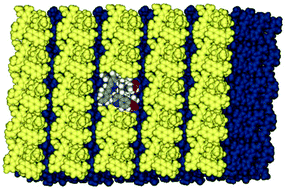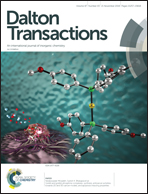Computational insights into the inhibition of β-haematin crystallization by antimalarial drugs†
Abstract
During the red blood cell phase of their life cycle, malaria parasites digest their host's haemoglobin, with concomitant release of potentially toxic iron(III) protoporphyrin IX (FePPIX). The parasites’ strategy for detoxification of FePPIX involves its crystallization to haemozoin, such that the build-up of free haem in solution is avoided. Antimalarial drugs of both historical importance and current clinical use are known to be capable of disrupting the growth of crystals of β-haematin, which is the synthetic equivalent of haemozoin. Hence, the disruption of haemozoin crystal growth is implicated as a possible mode of action of such drugs. However, the details of β-haematin crystal poisoning at the molecular level have yet to be fully elucidated. In this study, we have used a combination of density functional theory (DFT) and molecular modelling to examine the possible modes of action of ten different antimalarial drugs, including quinine-type aliphatic alcohols, amodiaquine-type phenols, and chloroquine-type aliphatic diamines. The DFT calculations indicate that each of the drugs can form at least one molecular complex with FePPIX. These complexes have 1 : 1 or 2 : 1 FePPIX : drug stoichiometries and all of them incorporate Fe–O bonds, formed either by direct coordination of a zwitterionic form of the drug, or by deprotonation of water. Most of the drugs can form more than one such complex. We have used the DFT model structures to explore the possible formation of a monolayer of each drug–haem complex on four of the β-haematin crystal faces. In all cases, the drug complexes can form a monolayer on the fast-growing {001} and {011} faces, but not on the slower growing {010} and {100} faces. Additional modelling of the chloroquine and quinidine complexes shows that individual molecules of these species can also obstruct the growth of new layers on other crystal faces. The implications of these observations for antimalarial drug development are discussed.



 Please wait while we load your content...
Please wait while we load your content...